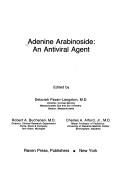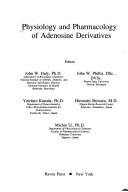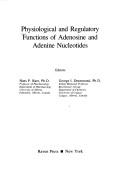| Listing 1 - 10 of 33 | << page >> |
Sort by
|

ISBN: 0720475473 0890040249 Year: 1975 Publisher: Amsterdam North-Holland Publishing Company
Abstract | Keywords | Export | Availability | Bookmark
 Loading...
Loading...Choose an application
- Reference Manager
- EndNote
- RefWorks (Direct export to RefWorks)
Dissertation
Year: 1987 Publisher: Liège : Université de Liège. Faculté de Médecine. Institut supérieur d'éducation physique,
Abstract | Keywords | Export | Availability | Bookmark
 Loading...
Loading...Choose an application
- Reference Manager
- EndNote
- RefWorks (Direct export to RefWorks)
ADENINE NUCLEOTIDE TRANSLOCASE --- MITONCHONDRIA, HEART --- RATS --- ADENINE NUCLEOTIDE TRANSLOCASE --- MITONCHONDRIA, HEART --- RATS

ISBN: 0890048339 9780890048337 Year: 1983 Publisher: New York (N.Y.): Raven Press
Abstract | Keywords | Export | Availability | Bookmark
 Loading...
Loading...Choose an application
- Reference Manager
- EndNote
- RefWorks (Direct export to RefWorks)
Adenylic acid --- Adenosine --- Adenine nucleotides --- Neurotransmitters --- Physiological effect --- Testing --- Congresses --- -Adenosine --- -Adenylic acid --- -Neurotransmitters --- #Lilly --- Chemical nerve transmitters --- Nerve transmitter substances --- Neural transmitters --- Neurohumors --- Neuroregulators --- Synaptic transmitters --- Transmitters, Chemical nerve --- Transmitters, Synaptic --- Neurochemistry --- Neural transmission --- Adenine ribonucleotide --- Adenine-ribose phosphate --- Adenosine monophosphate --- Adenosine phosphate --- Adenosine phosphoric acid --- AMP (Biochemistry) --- Adenine --- Adenine nucleoside phosphates --- Adenosine phosphates --- Purine nucleotides --- Adenocard --- Adenoscan --- Purine nucleosides --- Ribonucleosides --- Adenylic acid - Physiological effect --- Adenosine - Physiological effect --- Adenosine - Testing --- Adenine nucleotides - Congresses --- Adenosine pharmacology --- Adenosine physiology

ISBN: 0890043051 9780890043059 Year: 1979 Publisher: New York
Abstract | Keywords | Export | Availability | Bookmark
 Loading...
Loading...Choose an application
- Reference Manager
- EndNote
- RefWorks (Direct export to RefWorks)
Animal physiology. Animal biophysics --- Pharmacology. Therapy --- Human physiology --- Metabolism --- Adenine nucleotides --- Adenosine --- Regulation --- Congresses --- Physiological effect --- Metabolism - Regulation - Congresses --- Adenine nucleotides - Physiological effect - Congresses --- Adenosine - Physiological effect - Congresses
Dissertation
Year: 1987 Publisher: Wageningen : Landbouwuniversiteit,
Abstract | Keywords | Export | Availability | Bookmark
 Loading...
Loading...Choose an application
- Reference Manager
- EndNote
- RefWorks (Direct export to RefWorks)
Nucleoproteins --- Enzymes --- Flavonoids --- Metabolism --- Isolation --- Oxidoreductases --- Cytochromes --- Flavin mono nucleotide --- Nicotinamide adenine dinucleotide phosphate --- Nadph --- Native fmn --- Flavin mono nucleotide --- Nicotinamide adenine dinucleotide phosphate --- Nadph --- Native fmn
Book
Year: 2008 Publisher: Bruxelles: UCL,
Abstract | Keywords | Export | Availability | Bookmark
 Loading...
Loading...Choose an application
- Reference Manager
- EndNote
- RefWorks (Direct export to RefWorks)
Eukaryotic cells express efflux pumps capable of expelling a wide variety of drugs. Previous studies from our laboratory have demonstrated that Ciprofloxacin, a Fluoroquinolone, is substrate for a Mrp transporter in J774 macrophages and that chronic exposure of these cells to Ciprofloxacin selects for resistant cells that over-express Mrp2 and Mrp4.
The aim of this work is to examine in wild-type and Ciprofloxacin-resistant macrophages the potential competition between Ciprofloxacin and some preferential substrates of Mrp2 and Mrp4, to better characterize the transporter of this Fluoroquinolone. The selected substrates are PMEA (Adefovir), Saquinavir and Ritonavir which are antiviral agents belonging respectively to the class of Nucleotidic Reverse Transcriptase Inhibitors and Protease Inhibitors. PMEA is described so far as a substrate for MRP4 and MRP5; Saquinavir and Ritonavir, for MRP1 and MRP2. These competition studies showed that:
- Ciprofloxacin and PMEA accumulation is markedly reduced in Ciprofloxacin-resistant cells;
- High concentrations of the PMEA prodrug, Bis(POM)PMEA, and of Saquinavir increase Ciprofloxacin accumulation, in both cell types;
- Ritonavir does not affect Ciprofloxacin accumulation;
- Ciprofloxacin increase PMEA accumulation in both cell types. Our data therefore suggest that Ciprofloxacin and PMEA are both substrates and inhibitors of a same transporter overexpressed in Ciprofloxacin-resistant cells, while Saquinavir is only inhibitor of the same transporter. These data confirm the fact that the Ciprofloxacin transporter is truly a multidrug transporter and highlight potential drug interactions between Ciprofloxacin and antiviral agents, due to competition for transport Les cellules eucaryotes expriment des pompes à efflux capables d’expulser un grand nombre de médicaments. Les travaux antérieurs du laboratoire ont montré que la Ciprofloxacine, une Fluoroquinolone, était substrat d’un transporteur Mrp dans les macrophages J774 et que l’exposition chronique de ces cellules à la Ciprofloxacine sélectionnait des cellules résistantes surexprimant la Mrp2 et la Mrp4. Le but de notre travail est d’examiner dans les macrophages sauvages ou résistants la compétition potentielle entre la Ciprofloxacine et des substrats préférentiels de Mrp2 et Mrp4, afin de mieux caractériser le transporteur de cette Fluoroquinolone. Les trois substrats utilisés, le PMEA (Adefovir), le Saquinavir et le Ritonavir, sont des agents antiviraux appartenant respectivement à la classe des Inhibiteurs Nucléosidiques de la Transcriptase Inverse et à la classe des Inhibiteurs de Protéase. Le PMEA est décrit comme substrat préférentiel de la MRP4 et la MRP5, le Saquinavir et le Ritonavir, de la MRP1 et MRP2. Ces études de compétition ont démontré :
- La forte réduction de l’accumulation de Ciprofloxacine et de PMEA dans les cellules résistantes à la Ciprofloxacine ;
- L’augmentation de l’accumulation de Ciprofloxacine dans les deux types cellulaires, en présence de concentrations élevées de la prodrogue du PMEA, le Bis(POM)PMEA et de Saquinavir ;
- L’absence d’effet du Ritonavir sur l’accumulation de la Ciprofloxacine ;
- L’augmentation de l’accumulation de PMEA dans les deux types cellulaires en présence de Ciprofloxacine. Nos données suggèrent dès lors que la Ciprofloxacine et le PMEA sont à la fois substrats et inhibiteurs d’un même transporteur surexprimé dans les cellules résistantes à la Ciprofloxacine, tandis que le Saquinavir serait inhibiteur de ce même transporteur. Elles soulignent également le caractère de transporteur multidrogue des MRPs et indiquent des interactions médicamenteuses potentielles entre Ciprofloxacine et certains antiviraux par compétition pour un même transporteur
Eukaryotic Cells --- Ciprofloxacin --- Multidrug Resistance-Associated Proteins --- Macrophages --- Adenine --- Anti-Bacterial Agents --- Antiviral Agents --- Fluoroquinolones
Book
Year: 2012 Publisher: Bruxelles: UCL,
Abstract | Keywords | Export | Availability | Bookmark
 Loading...
Loading...Choose an application
- Reference Manager
- EndNote
- RefWorks (Direct export to RefWorks)
Book
Year: 1970 Publisher: Stuttgart : Thieme,
Abstract | Keywords | Export | Availability | Bookmark
 Loading...
Loading...Choose an application
- Reference Manager
- EndNote
- RefWorks (Direct export to RefWorks)
Adenine nucleotides --- Adipose tissue, drug effects. --- Adipose tissue --- Lipids --- Metabolism. --- Metabolism. --- Metabolism.
Book
ISBN: 3319088947 3319088939 Year: 2014 Publisher: Cham : Springer International Publishing : Imprint: Springer,
Abstract | Keywords | Export | Availability | Bookmark
 Loading...
Loading...Choose an application
- Reference Manager
- EndNote
- RefWorks (Direct export to RefWorks)
ATP was naturally selected very early on as the main source of biological energy, and thus became an indispensable feature of life on the Earth. This was a critical evolutionary choice because it shaped enzymatic systems to utilize ATP in energy-dependent reactions and necessitated an appearance of the universal intracellular signaling system based on calcium ions; keeping cytosolic Ca2+ extremely low became vitally important, since otherwise insoluble Ca2+-phosphates would preclude the cell energetics. Thus, all living cells on the Earth, beginning from the most primitive ones, had high cytosolic concentrations of ATP and there is little surprise that ATP was soon utilized by nature for another fundamental function of sending information from one living cell to another. In summary, ATP acts as the main energy source and is pivotal for numerous signaling cascades both inside (by fueling various transport systems and donating phosphate groups) and between the cells (by chemical transmission). Similarly, glutamate acts as an important molecule for both intercellular signaling through glutamatergic transmission and cell energetics by contributing to ATP production. In this collection of chapters, written by the leading experts in the fields of cell metabolism and energetics, intracellular signaling and neurotransmission, we covered various aspects of the interfacing between these two fundamental molecules. This book will be particularly useful for researchers, students, physicians and psychotherapists working in the field of neurobiology, neurology and psychiatry.
Glutamic acid --- Adenosine triphosphate --- Metabolism. --- Adenosinetriphosphate --- Adenosinetriphosphoric acid --- Adenylpyrophosphate --- ATP (Biochemistry) --- Adenine nucleotides --- Phosphates --- Glutamate --- Excitatory amino acids --- Umami (Taste) --- Neurosciences. --- Neurobiology. --- Neurosciences --- Neural sciences --- Neurological sciences --- Neuroscience --- Medical sciences --- Nervous system
Book
ISBN: 0435620541 Year: 1969 Publisher: London : Heinemann Educational Books,
Abstract | Keywords | Export | Availability | Bookmark
 Loading...
Loading...Choose an application
- Reference Manager
- EndNote
- RefWorks (Direct export to RefWorks)
Animal physiology. Animal biophysics --- Adenosine triphosphate. --- Muscle contraction. --- Muscle Contraction. --- Muscle Proteins. --- Adenosine triphosphate --- Muscle contraction --- Contraction of muscles --- Muscles --- Contractility (Biology) --- Adenosinetriphosphate --- Adenosinetriphosphoric acid --- Adenylpyrophosphate --- ATP (Biochemistry) --- Adenine nucleotides --- Phosphates --- Contraction --- Motility
| Listing 1 - 10 of 33 | << page >> |
Sort by
|

 Search
Search Feedback
Feedback About
About Help
Help News
News